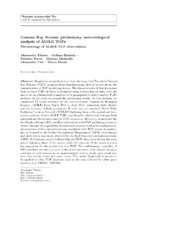| dc.description.abstract | Despite the recognition from their discovery that terrestrial gamma ray flashes (TGFs) originate from thunderstorms, little is known about the TGF-producing storms. The characteristics of such thunderstorms are investigated here using meteorological data, with the aim to set up a framework of analysis to be propagated to more complete TGF archives. In this work, we present the preliminary results. As first analysis, we considered 72 events detected by the Astrorivelatore Gamma ad Immagini Leggero (AGILE) from March 2015 to June 2015, estimating their electric activity in terms of flash production. To this end, we examined World Wide Lightning Location Network lightning data in the spatial and temporal proximity of each AGILE TGFs, searching for relationship between flash rate peak and distribution and the TGF occurrence. Moreover, we analyzed the low-Earth orbiting (LEO) satellite observation of the TGF-producing storms to define, through the capabilities of microwave sensors (both active and passive), the structure of the convective storms correlated with TGF events. In particular, we focused on the Global Precipitation Measurement (GPM) observations and show here a case study observed by the dual-frequency precipitation radar (DPR). Preliminary results indicate that the TGF often occur during the most active lightning phase of the storm, while the intensity of the storm is not a key ingredient for the production of a TGF. The multisensory capability of LEO satellites provide a picture of the storm structure, that, despite the poor coverage, is an unprecedented tool to study such cloud system over remote areas and open ocean. This study framework is meant to be applied to other TGF database, such as the ones collected by other space missions (e.g., FERMI, RHESSI). | en_US |
